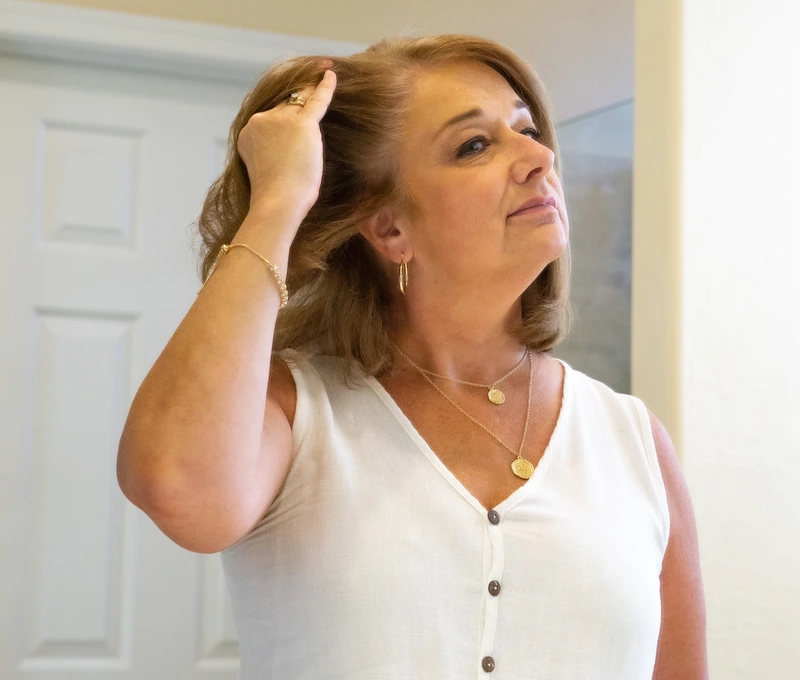Hair thinning and shedding are common experiences for women entering perimenopause and menopause. As hormone levels shift, many notice subtle but steady changes in their hair, such as a widening part, increased hair strands on their brush, and a gradual loss of volume.
This pattern of hair loss, known as female-pattern hair loss (FPHL), is the most common type of hair loss in women. It typically progresses slowly but can be difficult to reverse without treatment.(1) These changes can affect confidence and quality of life for many women.
One of the most widely recommended options for FPHL is minoxidil. It’s available in two main forms: topical, which is applied directly to the scalp, and oral, taken in low doses as a tablet. Each has advantages, and recent research has sparked growing interest in comparing the two.
This article explores topical and oral minoxidil, their effectiveness, ideal use cases, potential side effects, combination options, and expected results.
Types of Minoxidil
Minoxidil stimulates hair growth in all its forms, but each type works differently in the body and requires a different usage method.
Topical minoxidil is available in various forms, including solution, foam, serum, and spray.(1)
Oral minoxidil is available as a low-dose tablet (usually 0.25 to 2.5 mg/day).(1)
Sublingual minoxidil is an emerging option that is placed under the tongue for better absorption. This form is still under research and not yet widely available.(2)
Topical Minoxidil for Female Hair Loss
Dermatologists have used topical minoxidil as the gold standard for treating female pattern hair loss for decades. They continue to recommend it as a first-line option because it’s widely available and backed by strong clinical research.
How It Works
When applied to the scalp, minoxidil widens blood vessels and improves circulation around the hair follicles. This brings more oxygen and nutrients to the roots, helping revive shrinking follicles and extend the hair’s growth phase. It also activates potassium channels and may influence gene expression involved in hair production.(3)
How to Use It
It’s recommended to apply minoxidil directly to a clean, dry scalp – rather than the length of the hair – using the dropper or foam applicator. The scalp should be completely dry before styling or using other hair products.
Benefits and Effectiveness
Topical minoxidil helps slow down shedding and improves hair density over time. Many women experience visible hair regrowth, especially in areas such as the crown or part line.
Clinical studies show that results usually begin after four to six months and continue to improve with ongoing use. It works best when started early and used consistently.(4)
Side Effects and Safety
Most women tolerate topical minoxidil well, but a few may notice the following side effects:
Scalp itching or irritation
Allergic dermatitis
Temporary increased hair shedding
Excessive facial hair growth
In some cases, these side effects are caused by propylene glycol, a common ingredient in liquid formulas. Switching to a foam version, which is alcohol-based but propylene glycol-free, can help minimize these reactions.
Topical minoxidil is safe for long-term use, but it needs to be applied continuously. Once stopped, any new growth typically sheds within a few months.
Oral Minoxidil for Female Hair Loss
Doctors first prescribed oral minoxidil to manage high blood pressure. Over time, they noticed that many patients experienced increased hair growth as a side effect. In recent years, clinicians have begun using low-dose oral minoxidil off-label to treat FPHL. It offers an alternative for women who don’t respond well to topical treatment or find it difficult to use consistently.
How It Works
Like the topical version, oral minoxidil increases blood flow to the hair follicles and helps shift hairs into the active growth phase (anagen). But instead of relying only on enzymes in the scalp, oral minoxidil is activated more efficiently through enzymes in the liver and blood platelets.
Dosing and Regimen
The most common starting dose is 0.25 mg to 1 mg per day, taken by mouth. Doses up to 2.5 mg are used in some cases under medical supervision. It’s usually taken once daily, with or without food.
Oral minoxidil is a prescription drug. It’s recommended to consult with a healthcare provider to monitor potential side effects and adjust the dose if needed.
Benefits and Effectiveness
Studies show that oral minoxidil can increase hair density and shaft thickness, especially in women who don’t respond well to topical treatment. Topical minoxidil remains the better-studied option and continues to show more consistent results, particularly when started early and used consistently.(5)
Oral minoxidil offers a practical alternative for women who want a simpler routine or who experience irritation with scalp applications. Many dermatologists now recommend low-dose oral minoxidil as a first- or second-line treatment, depending on individual goals and tolerability.
Side Effects and Safety
While most side effects are mild and manageable, oral minoxidil does enter the bloodstream, so it’s important to understand the risks:
Hypertrichosis (extra hair growth on face or body)
Fluid retention
Dizziness
Mild heart palpitations
Serious side effects, such as low blood pressure or a fast heart rate, are rare at low doses, especially in healthy individuals. Regular check-ins with a doctor are recommended when using oral minoxidil.

Topical vs. Oral Minoxidil: Head-to-Head Comparison
Aspect | Topical Minoxidil | Oral Minoxidil |
Which is more effective? | This is a proven first-line treatment with consistent therapeutic effect across studies. | This option is beneficial to those who don’t respond to topical treatment. Its overall effect may be less predictable. |
Which is easier to use? | Because it requires direct scalp application once or twice daily, this form can interfere with styling or can feel messy. | The pill is easy to take once daily and has better adherence for many due to its simplicity. |
What are the side effects? | Side effects are mostly localized: itching, irritation, dryness, or facial hair growth. | The following systemic effects are possible: hypertrichosis, fluid retention, palpitations, and dizziness. |
Who is it best for? | It’s best for early to moderate hair loss and is widely recommended as the first treatment option. | This option is often prescribed to patients who can’t tolerate topical forms or prefer a non-topical approach. |
Considerations for Women: Safety, Hormones, and Combination Treatments
When selecting an FPHL treatment, it’s important to consider how the therapy aligns with a woman’s overall health, hormonal balance, and long-term safety.
Hormonal Considerations
Minoxidil does not directly influence hormone levels, which makes it a safer option compared to hormone-modulating drugs like finasteride or dutasteride. However, since hair loss in women is often linked to hormonal shifts, such as those caused by PCOS, menopause, or postpartum changes, healthcare providers may assess hormone levels before starting treatment to ensure the best approach.
Sexual Side Effects
Unlike some anti-androgen medications, minoxidil is not associated with sexual side effects. This can be a crucial factor for women who are concerned about libido, mood, or hormonal disruption during treatment.
Combination Treatments
In some cases, combining minoxidil with other therapies may lead to better outcomes, especially when multiple factors influence hair loss. Here are some of the most commonly used add-on treatments and how they work:
Spironolactone: This oral medication works by blocking androgen receptors and lowering androgen levels in the body.
Nutritional Supplements: Nutrients like iron, biotin, and vitamin D play a key role in hair structure and growth. Iron helps oxygen reach the follicles, biotin supports keratin production, and vitamin D may help regulate the hair cycle. Supplementing deficiencies can improve hair quality and reduce breakage.
Low-Level Laser Therapy (LLLT): This uses safe, low-intensity light to stimulate hair follicles at the cellular level. It may increase blood flow, reduce inflammation, and encourage follicles to reenter the growth phase, particularly in individuals with thinning at the crown or part line.
Any combination treatment should be tailored to the individual and discussed with a healthcare provider to ensure safety and effectiveness.
Price Comparison
Access and pricing can vary based on the type of minoxidil, where it’s purchased, and whether a prescription is required. The table below provides a general overview to help compare options.(6)
Form | Availability | Price Range (USD) |
Topical Minoxidil | Over-the-Counter | $20–$40 |
Oral Minoxidil | Prescription | $15–$30 per month |
Conclusion
The best choice between topical and oral minoxidil depends on various factors, including symptoms and personal preference. Topical minoxidil is ideal for women seeking an FDA-approved treatment with minimal systemic side effects and who are willing to commit to daily scalp application, especially those with early to moderate hair loss.
Oral minoxidil becomes a compelling option for women who haven't responded well to topical treatment, prefer the simplicity of a once-daily pill, or experience scalp irritation with topical applications.
Finding the right form is important, but so is choosing the right strength. Some women may not see results with lower concentrations, such as 2% or 5%. Stronger options, such as 10% or 15%, may cause irritation or unwanted side effects.
That’s where a mid-strength solution can help. A 7% topical minoxidil serum may offer the right balance — strong enough to encourage regrowth, yet gentle enough for regular use.
With the right treatment plan and guidance from a healthcare provider, many women can regain thicker, fuller, and healthier hair at any stage of life.
